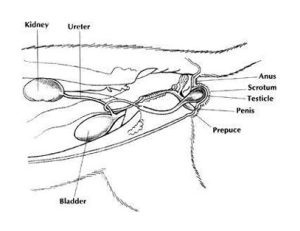The Classic Comprehensive Handbook of Cat Care
REPRODUCTIVE AND URINARY ORGANS
(GENITOURINARY SYSTEM)
MALE UROGENITAL ORGANS
Major portions of the male cat’s reproductive system are located externally within reach of your examination. Many cats resist a thorough examination of their genitals, however, so don’t feel dismayed if you can’t examine all parts as described. The testes (organs that produce sperm) are located in the scrotum (skin pouch) of the male kitten at birth or very shortly thereafter and should be relatively easy to feel by six weeks of age.
Normally there are two testicles present, each of which feels firm, smooth, and relatively oval beneath its loose covering of skin. If your cat has one or no testicles in his scrotum (unilateral or bilateral cryptorchidism) the condition may need veterinary attention. If you palpate carefully, you can feel a small lump protruding off the posterior end of each testicle. This is the tail of the epididymis, which stores sperm. To examine your cat’s penis you must first retract the skin fold which covers it (the prepuce or sheath).
To do this, grasp the prepuce gently but firmly between the index finger and thumb of one hand. Then push the skin fold anteriorly toward your cat’s head. As you do this you will see the pink tip of the penis start to protrude posteriorly; a cat’s penis points in the same direction as the tail. If you have gotten a successful grip the first time, the rest of the penis will protrude once the skin fold is pushed fully forward, and it will remain protruded as long as you hold the retracted skin in place. If you have difficulty retracting the sheath the first time, try getting a better grasp. Try several positions before giving up.
EXTRUDING THE PENIS
The surface of the penis is covered by a pink mucous membrane. Prominent curved, horny papillae protrude from its surface in the area of the glans (expanded end of the penis) in mature, uncastrated males (tomcats). It is thought that these rough projections may be involved in stimulating the female cat to ovulate following mating; they may also provide additional sexual stimulation to the male and act as a holdfast. If your cat is very young or castrated, you will find that the surface of the glans penis is smooth. The spines begin to develop at about six months of age and have usually disappeared by six months following castration. The urethra (tube through which urine and reproductive secretions pass) can be seen to open at the end of the penis. It is extremely narrow in all male cats. If you see your cat urinate, notice what a thin stream of urine this produces. Any secretions present on the surface of the penis should be clear, not cloudy or colored.
Sperm are produced in the seminiferous tubules of the testicles. From the testes the sperm travel to the epididymis for storage and maturation. During ejaculation sperm travel through the vas deferens into the urethra where they are mixed with secretions from the prostate gland and bulbourethral glands, which are located internally and are not accessible for routine examination.
The vulva and clitoris are the only female cat’s genitals that can be seen externally. The internal portions of the female reproductive tract—uterus, cervix, ovaries, and fallopian tubes—can be found on the illustrations here. The urethra empties into the vagina anterior to a point you can see without special instruments. You may be able to see the tiny, dark pink clitoris in its fossa by gently spreading the vulvar lips with your fingers. This also allows you to see some of thelining of the vulva and vagina. These mucous membranes should be pink in color; any secretions present are normally clear.
FEMALE REPRODUCTIVE SYSTEM
FEMALE GENITAL ANATOMY
You can find additional information on reproduction in the chapter Breeding and Reproduction, starting.
The urinary system of both male and female cats consists of two kidneys, two ureters, the bladder, and the urethra. Look for these organs on the illustrations. Nephrons (units of specialized cells) in the kidneys filter the blood to remove toxic metabolic wastes and are also important in maintaining the body’s proper electrolyte and water balance. Urine formed in the kidneys passes through the ureters to the bladder where it is stored until it is eliminated through the urethra during urination. Normal cat urine is yellow and clear and has a distinctive odor. This odor is extremely intense in tomcats and is used to mark territory during the act of spraying. The intensity of the yellow color of urine increases as the amount of water excreted decreases and vice versa. If your cat is not fat you will probably be able to feel the bladder and kidneys. With your cat standing, provide restraint with one hand under the chest while using the other one to feel for the bladder in the posterior abdomen between the rear legs. A bladder containing urine will feel somewhat like a water-filled balloon varying anywhere from about the size of a Concord grape to the size of a large lemon. Feel gently for the kidneys by grasping the abdomen with both hands, left on the left side, right hand on the right side. Reach high into the mid-lumbar area, then bring your fingers toward one another. Each kidney should feel firm, smooth, and relatively oval in shape. Most normal adult cat’s kidneys are about the size of a small apricot, but there is much individual variation with body size and with the amount of body fat, since a layer of fat normally covers the kidneys. You may find the right kidney somewhat more anterior than the left one, but both move rather freely and will not be found in exactly the same position in each examination.


